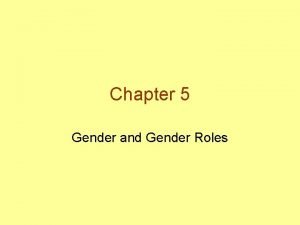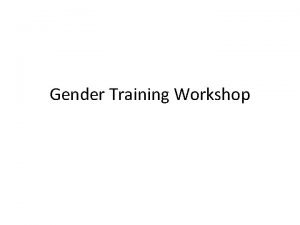What are the effects of gender on educational

























- Slides: 25

What are the effects of gender on educational attainment? Primary school boys fail to close gap with girls Boys are being failed by our schools Many teenage boys fail test grade Poor white boys 'most likely to fail school' Almost half of all boys fail to meet targets for writing Recent headlines taken from newspapers and websites Why aren't boys doing as well at school?

EVALUATING THE EFFECT OF GENDER ON SCHOOL ACHIEVEMENT Are boys educational failures?

What’s your opinion?

Sociological Targets To understand that gender can have an influence on school attainment. To recognise that traditional patterns of gender attainment are changing in favour of girls. To identify some of the effects that the growing confidence of girls is having on boys.

The problem for schools �Until the mid 1980 s, boys out-performed girls at all levels of the education system, with the exception of 11+ �Most educational writers read this as being 'proof' that girls were generally less intelligent than boys and that boys were 'late developers'. �Since the mid-1980 s both genders began to improve their school performance significantly. The improvement of girls was more rapid than that for boys.

Is this a problem? Warrington and Younger (1999) note that the success of girls should be a cause for celebration and congratulation. Instead it is viewed as a 'problem' with concern expressed about how males are 'failing’. Schools are now told to tackle the issue of the underachievement of boys.

Summary of patterns Before 1980 s boys were doing better Since then girls have out performed boys Boys still dominate science subjects at higher level In job market girls earning more up to age 26 Still men earn more overall Last year boys earned more A grades at A level Boys are improving just not as fast as girls Class still has a bigger impact

Discussion questions Why do you think male improvement in achievement has been at a lower rate to females? Why do you think female success is seen as a problem of boys 'failing'?

Possible reasons for changes: ranking exercise Girls and boys learn in different ways Schools are feminine environments Girls’ attitudes towards work are changing Young women are more personally confident Males are losing confidence and there is a crisis of masculinity Boys are rejecting school and developing ‘laddish’ attitudes.

Summary of explanations Girls and boys learn in different ways – GCSE advantages girls – return to old linear style Schools are feminine environments – female teachers favour girls – boys lack role models Girls’ attitudes towards work are changing – girls role models are now career women Young women are more personally confident Genderquake Males are losing confidence and there is a crisis of masculinity Boys are rejecting school and developing ‘laddish’ attitudes.

Task 1 Find the following key words in your booklets on Gender and educational attainment. Highlight them and make sure you understand the use of the term. Crisis of masculinity Cultural deprivation Discrimination Feminism Genderquake Hidden Curriculum Laddishness Ladettes Material deprivation Sexism

Task 2 Find out what the following researchers say about education and gender. Wilkinson (1994) Susan Faludi and Robert Bly Murphy and Elwood (1998) Mitsos and Browne (1998) Harris et al. (1993) Mac an Ghaill

Stimulus materials Look at the following graphs. Summarise what you learn about gender attainment from each of them.

Attainment of five A* - C GCSEs

Higher education

Important Research Study Sharpe (1976/1994) Used structured interviews so that views could be compared over time. In 1976 revealed girls’ priorities as being love, marriage, children, husband jobs in that order ! In 1994 this had changed to more career orientated aspirations. What are the potential problems with structured interviews? She used only a small sample !!

Key researchers Wilkinson (1994) refers to the 'genderquake' whereby young females are increasingly striving for a fulfilling career Susan Faludi and Robert Bly suggest male underachievement is linked to a 'crisis of masculinity‘ Murphy and Elwood (1998) argue that teachers are now more sensitive to gender issues facing females. Teaching has become a feminised profession

Researchers 2 �Mitsos and Browne (1998) found that in coeducation schools girls worked harder and spent more time on homework, were better organised, and were more likely to meet deadlines than boys. �Harris et al. (1993) found that boys were more easily distracted in the classroom �Post modernists argue that performance by gender is affected by the social class and ethnic backgrounds of male and female students. Thus, not all female students do well and all male students do badly. �For Mac an Ghaill, the underachievement of boys is particularly a working class problem.

AO 3 s Although girls may be doing better at examinations at school, this is not to say that females will make strides in achieving top managerial positions. Evidence from the work place and elsewhere support the assertion that female attitudes to success have changed, women have children later, and see careers and vital. A lot of the work lacks empirical data to support it. It is often small scale, and thus generalisations are difficult to make.

These studies give an up to date account of classroom attainment in the 1990’s. The work fails to take into account class differences. In reality it is not boys per se who fails, but working class boys. This debate is sterile. In reality it is a smokescreen to divert attention away from the real gains women have made, and to divert attention back again on the male of the species.

Many of the so-called initiatives were only narrow in their scope and can thus not be said to be responsible for added female achievement. Much empirical quantitative data show that this trend is consistent and widening, and thus cannot be dismissed easily.

Key Terms Crisis of masculinity Cultural deprivation Discrimination Feminism Genderquake Hidden Curriculum Laddishness Ladettes Material deprivation Sexism

Assessment Outline and explain why boys are now seen by many as the ‘gender of failure’ in Education.

Independent study Add to your notes by using the textbooks in the LRC and in your Sociology department. Use the e-book on the NGFL-Cymru website for more detailed notes and explanations.

Outline and explain patterns in gender and attainment (20) Outline patterns – statistics Give 4 -5 explanations with research evidence Analysis – return to the question – what does your point suggest about gender and attainment Evaluation – counterargue/criticise or give further support for your point. Use the correct signpost phrases/words for your points.
 Antigentest åre
Antigentest åre Strategic gender needs and practical gender needs
Strategic gender needs and practical gender needs Thiếu nhi thế giới liên hoan
Thiếu nhi thế giới liên hoan Alleluia hat len nguoi oi
Alleluia hat len nguoi oi điện thế nghỉ
điện thế nghỉ Vẽ hình chiếu vuông góc của vật thể sau
Vẽ hình chiếu vuông góc của vật thể sau Một số thể thơ truyền thống
Một số thể thơ truyền thống Hệ hô hấp
Hệ hô hấp Cong thức tính động năng
Cong thức tính động năng Bảng số nguyên tố lớn hơn 1000
Bảng số nguyên tố lớn hơn 1000 đặc điểm cơ thể của người tối cổ
đặc điểm cơ thể của người tối cổ Tỉ lệ cơ thể trẻ em
Tỉ lệ cơ thể trẻ em Các châu lục và đại dương trên thế giới
Các châu lục và đại dương trên thế giới ưu thế lai là gì
ưu thế lai là gì Thẻ vin
Thẻ vin Môn thể thao bắt đầu bằng chữ f
Môn thể thao bắt đầu bằng chữ f Tư thế ngồi viết
Tư thế ngồi viết Cái miệng nó xinh thế
Cái miệng nó xinh thế Hát kết hợp bộ gõ cơ thể
Hát kết hợp bộ gõ cơ thể Từ ngữ thể hiện lòng nhân hậu
Từ ngữ thể hiện lòng nhân hậu Tư thế ngồi viết
Tư thế ngồi viết Trời xanh đây là của chúng ta thể thơ
Trời xanh đây là của chúng ta thể thơ Thế nào là giọng cùng tên
Thế nào là giọng cùng tên Chó sói
Chó sói Thơ thất ngôn tứ tuyệt đường luật
Thơ thất ngôn tứ tuyệt đường luật Khi nào hổ con có thể sống độc lập
Khi nào hổ con có thể sống độc lập

















































